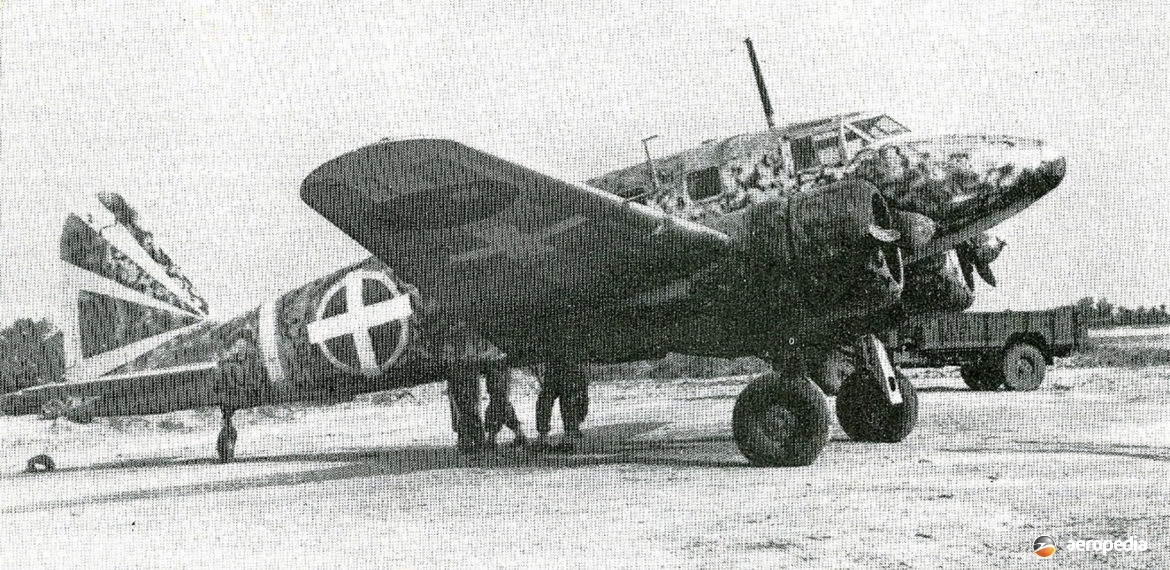Photograph:
Japanese Army Tachikawa Ki.54 Hickory on arrival at Labuan Island in Malaya in 1945 at the time of the Japanese surrender (AWM OG3491)
Country of origin:
Japan
Description:
Light liaison and communications military transport
Power Plant:
Two 380 kw (510 hp) Hitachi Ha-13-KO nine-cylinder air-cooled radial engines
Specifications:
- Wingspan: 17.90 m (58 ft 8⅔ in)
- Length: 11.94 m (39 ft 2⅛ in)
- Height: 3.58 m (11 ft 8⅞ in)
- Wing area: 40.00 m² (430.56 sq ft)
- Max speed at 2,000 m (6,560 m): 376 km/h (234 mph)
- Cruising speed: 240 km/h (149 mph)
- Climb to 5,000 m (16,405 ft) in: 20.4 mins
- Service ceiling: 7,180 m (22,555 ft)
- Range: 960 km (596 miles)
- Empty weight: 2,954 kg (6,512 lb)
- Loaded weight: 3,897 kg (8,591 lb)
Armament:
Four 7.69 mm (0.303 in) Type 89 machine guns; provision for practice bombs
History:
The Tachikawa Aircraft Co Ltd was founded in 1924 and was basically known for producing primary trainers for the Japanese Air Force from 1927. In 1940 work began on the Y.39, a low-wing twin-engine monoplane, which was built in a variety of variants to meet a number of needs. Designer was Ryokichi Endo and one of the design parameters was the aircraft was to have similar handling characteristics and performance to the bombers then entering service with the Japanese Army. It was to be crewed by a pilot, bombardier, navigator, gunner and radio operator, training for all these positions being provided on the one aircraft design. Flight characteristics were flight tested on a full-scale glider version with dummy engines. The prototype was flown in 1940.
Production commenced in 1941 as the Type 1 Advanced Trainer, Model A (the Ki.54a or Ki.54-Ko) with two 380 kw (510 hp) Ha-13a radial engines. It was used as a multi-engine pilot trainer. The Type 1 Operations Trainer Model B (Ki.54b or Ki.54-Otsu) was the next model and was for the training of bomber crews, having four positions for gunnery training, each with a flexible 7.69 mm (0.303 in) Type 89 machine gun. It saw service with many military and civil training schools, the latter under contract to the Japanese Army.
The Type 1 Transport Model C (Ki.54c or Ki.54-Hei) was a five to nine-seat light transport. Later in the war a model for submarine detection appeared, known as the Ki.54d or Ki.54-Tei. In 1945 work was proceeding on an all-wood variant of the Ki.54c, to be known as the K.110, but it was destroyed in an air-raid. Work re-commenced, the aircraft subsequently to be known as the Ki.114, but the end of the war intervened.
Of all metal construction with fabric covered movable control surfaces, the type was produced throughout World War II. A total of 1,368 examples was built and all were known to the Allies as the Hickory, no matter what variant it was.
One Ki.54c or Ki.54-Hei (incomplete) was for a time held by the RAAF Museum at RAAF Williams (Point Cook), VIC. On 10 September 1945 the Commander of the Japanese forces in North Borneo, General Baba, was flown in this aircraft to the island of Labuan where he surrendered his forces to Major General Wootten, Officer Commanding the Australian 9th Division. Here the aircraft remained until its importance was realised and, although damaged by souvenir hunters, it was repaired, crated, and despatched to Australia.
It remained crated for some time, the aircraft being at various stages with No 81 Wing RAAF, and No 1 Aircraft Depot, Laverton, VIC being noted at the latter in April 1946. Little is known of its history thereafter but at one stage it was earmarked for the Australian War Memorial in Canberra, ACT as an historic exhibit. However, somehow the fuselage became part of a children’s playground equipment at RAAF Fairbairn, ACT in the 1950s. It would appear at about this stage the wings, tail assembly and engines were scrapped. Here it stayed until salvaged in April 1980 and conveyed to Point Cook where work commenced on restoration for display. The aircraft in recent years has been stored at the AWM’s Treloar storage facility awaiting restoration.
Other Ki.54s survive: a Ki.54c (converted from Ki.54a standard) is in the Beijing Aviation Museum in China and was a captured war prize; and a complete aircraft (c/n 5541) which ditched in Lake Towada on Honshu Island on 27 September 1943 was located in 2012 and has been recovered for the Aomori Prefectural Misawa Aviation Science Museum in Japan.

